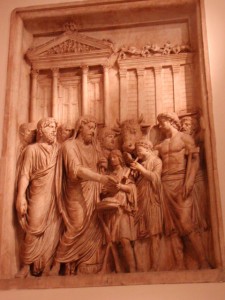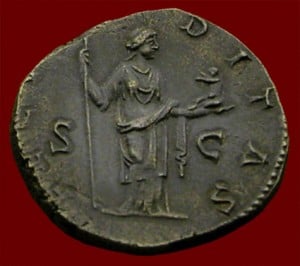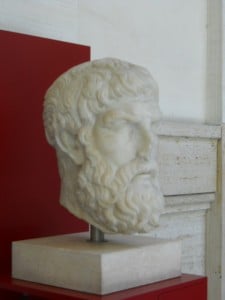“Lares, gods of my fathers, preserve me!
While young and still nursing,
you guided me when I played at your feet.”
~ Tibullus I.x.15

At a makeshift altar of built-up turf, young Gaius’ family had come to meet with their gruff neighbor, Aulius Curius. Atop this altar Gaius’ father and the other man had built a frame of sticks. His mother and another woman each held out lebetes, deep basins in which they each carried hot coals from their respective hearths. The coals were placed in the wooden frame, and more kindling was added until a flame arose in the focus. Curius and Gaius’ father then each placed a wreath of laurel on the altar, their sweet scent and crackling sounds filled the air. Urged forward by his mother, Gaius brought a basket of fruits to the altar. His older sister Titia then shook out an offering from his basket into the fire. Titia next took honey-cakes from a patella, careful not to handle or drop any as each was offered into the flame. The other members of Gaius’ family and their neighbor Aulius Curius as well then poured offerings of wine to Terminus. Lambs and a suckling pig were slaughtered, their blood poured as another libation into a ditch dug around the boundary stone that marked each homestead’s land. The meat of the animals were roasted for a feast among the neighbors. It was the first time that young Gaius had participated in a ritual outside his family’s house, in front of strangers. He was quite pleased by his performance, as everyone else seemed to be, too. And Aulius Curius no longer seemed so gruff, as he and Gaius’ father held a jovial argument over how much wine Gaius should be allowed to drink. Gaius beamed from all the watered wine that Curius let him sip. Then sitting in Curius lap, his head pressed against the old man’s chest, Gaius fell fast asleep while listening to the rhythm of a strong heartbeat.
Through such ceremonies, from the moment a child is born, he learns the traditions of his family. At first, days after his birth, he was only half-aware of his father lifting him into the air towards the Gods and presenting him to the rest of the family. He was unaware of his uncles posing as Picumnus, Intercidona and Deuerra, who wrapped at the doors and windows around his house to protect him from Silvanus stealing the infant away. As he grew older he joined with his family before hearth and lararium to offer prayers each day to the family ancestors and to the Gods. He was told tales of the heroic deeds performed by his forefathers, and the myths of the mighty Gods. After he had learned the rites of his household, he passed on to other rites where he met his family’s neighbors, just as young Gaius had in the story above. Then in public festivals he entered into a larger community. One day Gaius would travel to Rome at Liberalia, there to put aside his childhood, don the toga virilis to become a man and a citizen of Rome. At each passage of his life, Gaius would participate in other ceremonies, festivals, private rites, someday to marry, present his own children to the Gods and then to his neighbors and his community. Later still rites would be performed for Gaius after he passed, his own descendents making offerings to him when he returned to his family, himself becoming an ancestor among the Lares.
Religion is about community; community with your family, your neighbors, the world at large, and community with the still greater Universe around us. Religion is a matter of practice, a way of life while walking with the Gods. In this course on Roman ritual we will discuss ancient practices within the tradition of the religio Romana. In the posts I shall be making in the weeks ahead, drawn from lectures I gave eight years ago, I will touch on various ceremonies and rituals at different levels of what was Roman society. These will serve as examples for us to focus on the various elements of what is formal Roman ritual. At the same time, readers should practice the various ritual elements, building on these to form their own ritual practice. Young Gaius had a lifetime to study and practice within the religio Romana, and a community to support him. Modern practitioners of the Religio Romana must try to immerse themselves as much as possible into the world Gaius lived and that can only be accomplished by doing Roman ritual.
There were two concurrent streams of practice in the religio Romana. On the one hand, the religio Roman emerged from earlier traditions, a way of doing things that lent itself to the formal practice of the Religio Romana. At the same time, the Religio Romana had originated in an ecstatic tradition where a person regularly communed directly with the Gods. Roman rituals were highly emotive and wove through different emotions at different phases in a ceremony. They were festive and celebratory, at moments somber and serious, followed by feasting and spectacles. Some rites were described as initiations that could play on very strong emotions and elicit the practitioner to identify himself or herself with the Gods and Goddesses of Rome. Other rituals led to an incubation where the practitioner prepared to meet with the Gods in dream; while still others led one into an ecstatic experience of the Gods. Most Roman rituals, however, were ceremonial in which meaning of their content related to family memories as Gaius would have had, or on experiences within the more ecstatic rites. Experience in the tradition gave meaning to every detail of Roman ritual. Here I will deal primarily with the formal elements of Roman ritual. Suggested exercises will deal in part with ritual elements that can lead toward the more ecstatic form of the tradition. Further discussions will try, then, to tie together the formal and the ecstatic currents to develop a richer practice in the Roman tradition.















